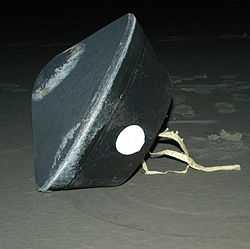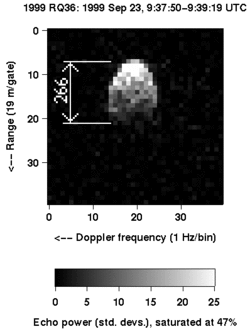101955 Bennu
|
| |||||||||||||||||
| Designations | |||||||||||||||||
|---|---|---|---|---|---|---|---|---|---|---|---|---|---|---|---|---|---|
| MPC designation | 101955 | ||||||||||||||||
Named after | Bennu | ||||||||||||||||
| 1999 RQ36 | |||||||||||||||||
| Apollo | |||||||||||||||||
| Orbital characteristics | |||||||||||||||||
| Aphelion | 1.356 AU | ||||||||||||||||
| Perihelion | 0.897 AU | ||||||||||||||||
| 1.126 AU | |||||||||||||||||
| Eccentricity | 0.204 | ||||||||||||||||
|
436.604 d (1.20 a) | |||||||||||||||||
| 193.420° | |||||||||||||||||
| Inclination | 6.035° | ||||||||||||||||
| 2.068° | |||||||||||||||||
| Physical characteristics | |||||||||||||||||
Mean radius | 247 ± 10 m[3] | ||||||||||||||||
Equatorial radius | 273 ± 8 m[3] | ||||||||||||||||
| Mass | 1.4×1011 kg[4] | ||||||||||||||||
| Albedo | 0.03–0.06[5] | ||||||||||||||||
| |||||||||||||||||
|
| |||||||||||||||||
101955 Bennu (provisional designation 1999 RQ36)[6] is an Apollo asteroid discovered by the LINEAR Project on September 11, 1999. It is the planned target of the OSIRIS-REx mission which is intended to return samples to Earth for further study.[7][8] It is a potential Earth impactor and is listed on the Sentry Risk Table with the third highest rating on the Palermo Technical Impact Hazard Scale.[9]
101955 Bennu has a mean diameter of approximately 493 meters and has been observed extensively with the Arecibo Observatory Planetary Radar and the Goldstone Deep Space Network.[2][3][10]
Possible Earth impact
On average, an asteroid with a diameter of 500 meters can be expected to impact Earth about every 130,000 years or so.[11]
A 2010 dynamical study by Andrea Milani and collaborators had located a series of eight potential Earth impacts between 2169 and 2199. The cumulative probability of impact is dependent on physical properties of Bennu that were poorly known at the time, but was not found to exceed 0.07% for all eight encounters.[12] The authors recognized that an accurate assessment of 101955 Bennu's probability of Earth impact would require a detailed shape model and additional observations (either from the ground or from spacecraft visiting the object) to determine the magnitude of the Yarkovsky acceleration.
After the publication of the shape model and astrometry based on radar observations obtained in 1999, 2005, and 2011,[3] it was possible to estimate the Yarkovsky acceleration and to revise the impact assessment. The current (as of 2014) best estimate of the impact probability is a cumulative probability of 0.037% in the interval 2175 to 2196.[13] This corresponds to a score on the Palermo scale of −1.70.
Spacecraft missions
Separately, 101955 Bennu has been considered many times as the target of spacecraft missions, including OSIRIS-REx, due to the low Δv[14] required to reach it from Earth orbit. NASA announced on May 25, 2011, that OSIRIS-REx had been selected as part of NASA's New Frontiers Program.[8] The spacecraft is scheduled to launch in 2016, reach 101955 Bennu in 2019 and return samples to Earth in 2023.[8]
Name
Bennu was named by Michael Puzio, a third-grader from North Carolina, one of more than eight thousand students from dozens of countries around the world who entered a "Name That Asteroid!" contest run by the University of Arizona, The Planetary Society, and the LINEAR Project, according to The Planetary Report, June 2013. Its name refers to the Egyptian mythological bird Bennu, which Puzio thought the spacecraft, OSIRIS-REx, including its TAGSAM arm, resembled.[15]
Gallery
-

Artist concept of OSIRIS-REx at asteroid Bennu.[1]
-

Illustration of OSIRIS-REx collecting a sample from asteroid Bennu.
-

Sample return capsule from the Stardust mission.
-
Asteroid Bennu is thought to contain materials present when the Solar System was first formed.
- ^ Brown, Dwayne; Jones, Nancy Neal (January 15, 2014). "NASA RELEASE 14-017 - NASA Invites Public to Send Names on an Asteroid Mission and Beyond". NASA. Retrieved January 16, 2014.
See also
- List of asteroids targeted for spacecraft visitation
- (341843) 2008 EV5
References
- ↑ "The Shape and Spin of 101955 (1999 RQ36) from Arecibo and Goldstone Radar Imaging".
- ↑ 2.0 2.1 "Goldstone Delay-Doppler Images of 1999 RQ36". Asteroid Radar Research. Jet Propulsion Laboratory.
- ↑ 3.0 3.1 3.2 3.3 Nolan, M. C.; Magri, C.; Benner, L. A. M.; Giorgini, J. D.; Hergenrother, C. W.; Howell, E. S.; Hudson, R. S.; Lauretta, D. S.; Margot, J. -L. (2012). "The Shape of OSIRIS-REx Mission Target 1999 RQ36 from Radar and Lightcurve Data". Asteroid Comet Meteors 2012 Conference 1667: 6345. Bibcode:2012LPICo1667.6345N.
- ↑ "101955 1999 RQ36: Earth Impact Risk Summary". NASA. Jet Propulsion Laboratory. August 5, 2010. Retrieved 24 November 2013.
- ↑ Emery, J. P.; Fernández, Y. R.; Kelley, M. S.; Hergenrother, C. (2010). "Thermophysical Characterization of Potential Spacecraft Target (101955) 1999 RQ36" (PDF). 41st Lunar and Planetary Science Conference 1533: 2282. Bibcode:2010LPI....41.2282E.
- ↑ We have a winner! The OSIRIS-REx asteroid's name is: Bennu!
- ↑ Brown, Dwayne; Neal-Jones, Nancy (March 31, 2015). "RELEASE 15-056 - NASA’s OSIRIS-REx Mission Passes Critical Milestone". NASA. Retrieved April 4, 2015.
- ↑ 8.0 8.1 8.2 "NASA to Launch New Science Mission to Asteroid in 2016". NASA. 25 May 2011. Retrieved 21 May 2013.
- ↑ "Sentry Risk Table". NASA/JPL Near-Earth Object Program Office. Retrieved 2014-03-26.
- ↑ Hudson, R. S.; Ostro, S. J.; Benner, L. A. M. "Recent Delay-Doppler Radar Asteroid Modeling Results: 1999 RQ36 and Craters on Toutatis". Bulletin of the American Astronomical Society (American Astronomical Society) 32: 1001. Bibcode:2000DPS....32.0710H.
- ↑ Robert Marcus, H. Jay Melosh, and Gareth Collins (2010). "Earth Impact Effects Program". Imperial College London / Purdue University. Retrieved 2013-02-07. (solution using 2600kg/m^3, 17km/s, 45 degrees)
- ↑ Milani, Andrea; Chesley, Steven R.; Sansaturio, Maria Eugenia; Bernardi, Fabrizio; Valsecchi, Giovanni B.; Arratia, Oscar (2009). "Long term impact risk for (101955) 1999 RQ36". Icarus 203 (2): 460–471. arXiv:0901.3631. Bibcode:2009Icar..203..460M. doi:10.1016/j.icarus.2009.05.029.
- ↑ Chesley, Steven R.; Farnocchia, Davide; Nolan, Michael C.; Vokrouhlický, David; Chodas, Paul W.; Milani, Andrea; Spoto, Federica; Rozitis, Benjamin; Benner, Lance A.M.; Bottke, William F.; Busch, Michael W.; Emery, Joshua P.; Howell, Ellen S.; Lauretta, Dante S.; Margot, Jean-Luc; Taylor, Patrick A. (2014). "Orbit and bulk density of the OSIRIS-REx target Asteroid (101955) Bennu". Icarus 235: 5–22. arXiv:1402.5573. Bibcode:2014Icar..235....5C. doi:10.1016/j.icarus.2014.02.020. ISSN 0019-1035.
- ↑ Near-Earth Asteroid Delta-V for Space Rendezvous
- ↑ Nine-Year-Old Names Asteroid Target of NASA Mission in Competition Run By The Planetary Society
External links
- Earth Impact Risk Summary: 101955 1999 RQ36 (Years: 2169–2199) – JPL near-Earth object website
- Orbit parameters – NASA website
- Temperature History and Dynamical Evolution of (101955) 1999 RQ 36: A Potential Target for Sample Return from a Primitive Asteroid (2011 ApJ 728 L42)
- Physical Properties of OSIRIS-REx Target Asteroid (101955) 1999 RQ36 derived from Herschel, ESO-VISIR and Spitzer observations (arXiv:1210.5370 : 19 Oct 2012)
- The Design Reference Asteroid for the OSIRIS-REx Mission Target (101955) Bennu (arXiv:1409.4704 : 16 Sep 2014)
| ||||||||||||||||||||||||||||||||


